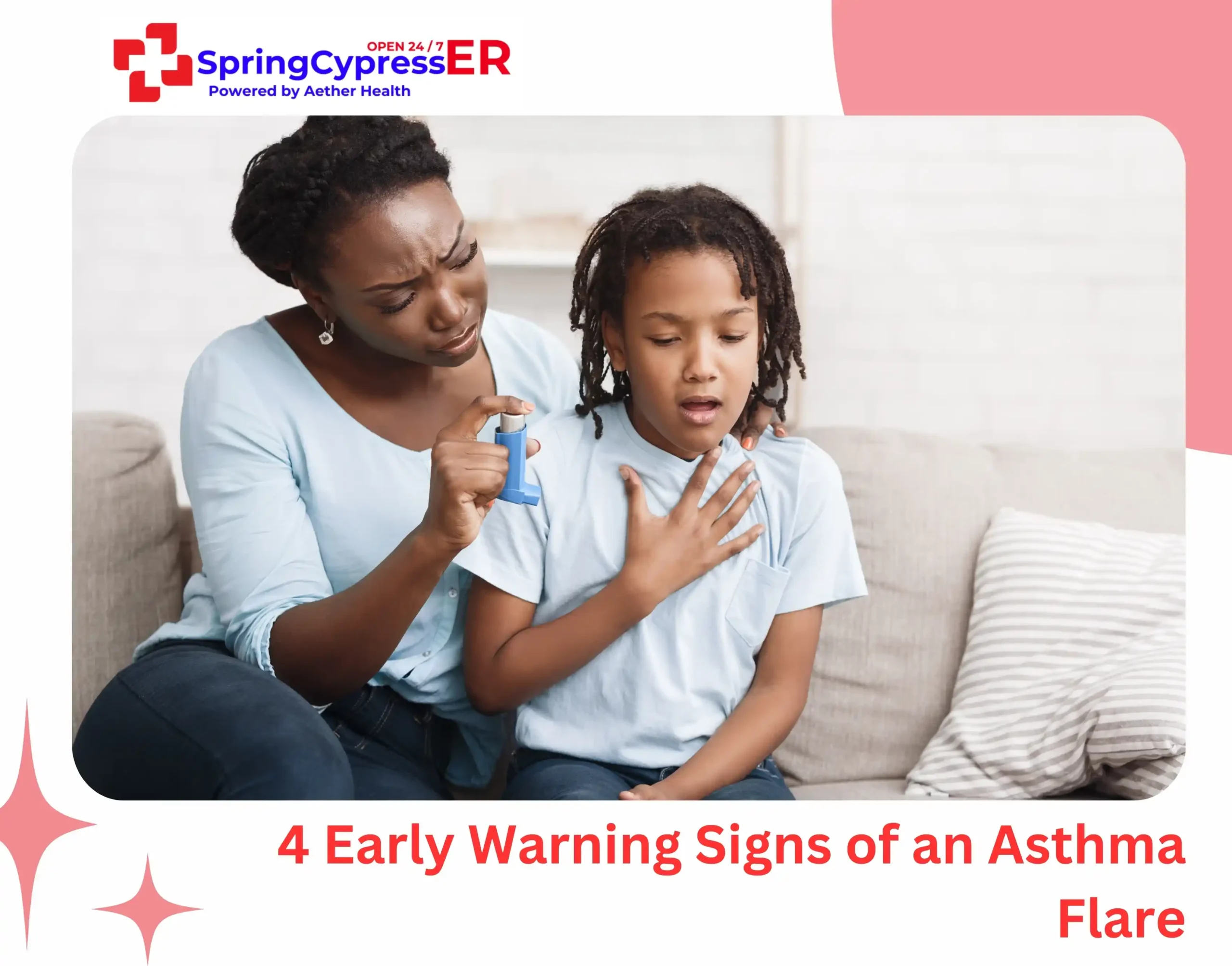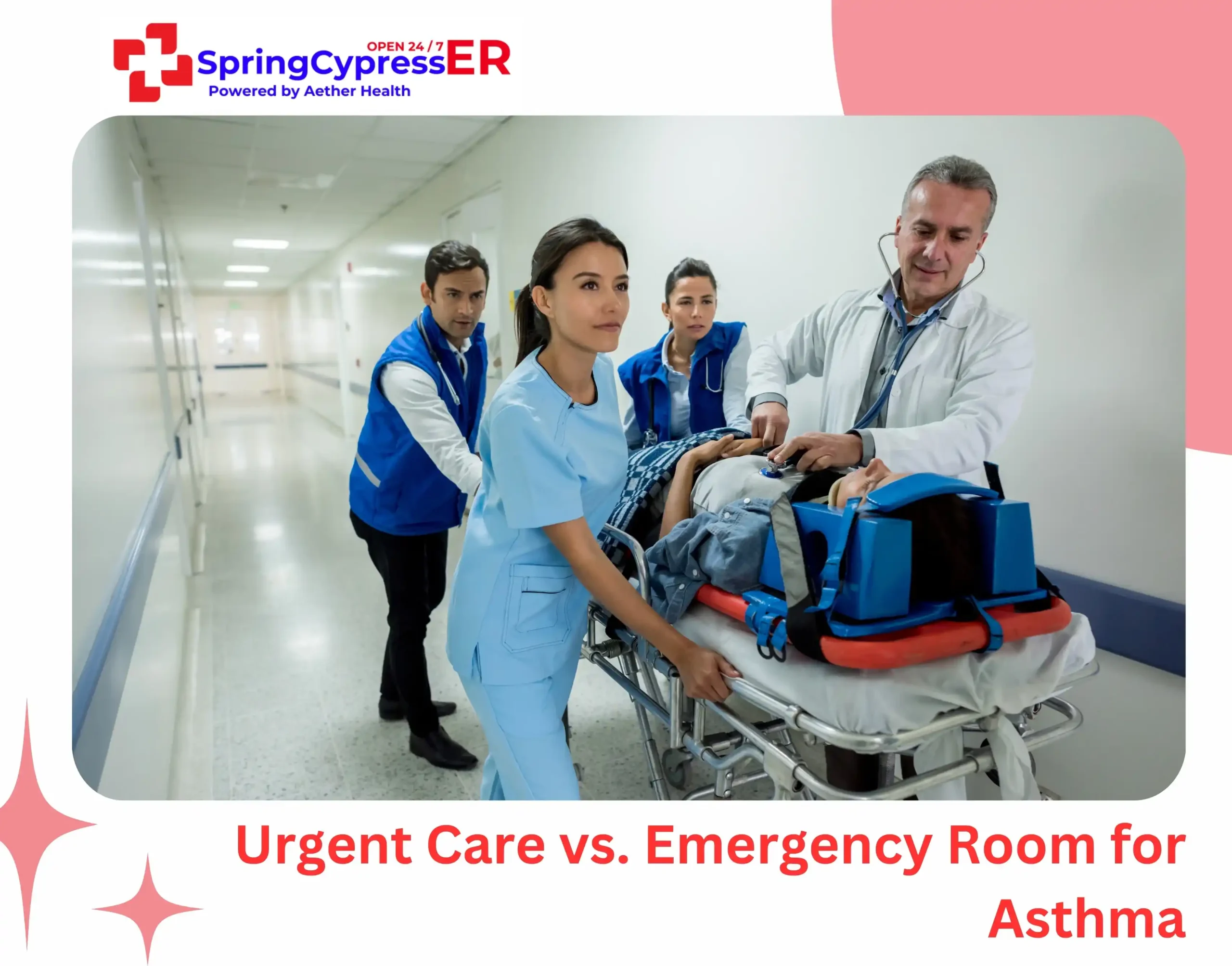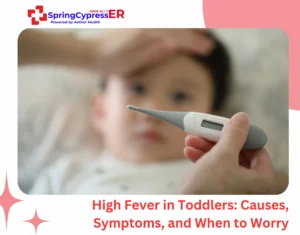The real danger in asthma isn’t the attack itself; it’s not knowing when to call for help. During a severe asthma attack, the airways can narrow to the size of a drinking straw within minutes due to muscle tightening, swelling, and mucus buildup.
During a severe flare, oxygen levels can drop below 90% quickly, sometimes without obvious symptoms, and that can be life-threatening. That’s why it’s so important to know when to stop trying to manage it at home and head to the ER.
Let’s break down the warning signs, when to go to ER for asthma, and what to expect once you’re there.
4 Early Warning Signs of an Asthma Flare

Not every asthma symptom requires emergency care. Most can be managed at home with the use of a rescue inhaler. Early signs of an asthma flare include:
- Coughing fits that worsen at night or early in the morning
- Mild chest tightness or a feeling of pressure in the chest
- Shortness of breath with physical activity, such as climbing stairs
- Wheezing, a whistling sound when exhaling
If these symptoms improve after using your quick relief inhaler, you may not need emergency care. However, it’s important to remain vigilant, as asthma symptoms can escalate quickly.
7 Red Flags: When to Go to ER for Asthma
You should seek emergency medical care immediately if you experience any of the following:
- Severe shortness of breath: Struggling to breathe even while resting or unable to speak in complete sentences.
- No relief from inhaler use: If your rescue inhaler doesn’t work after repeated use within 15–20 minutes.
- Bluish lips, face, or fingertips: A sign of dangerously low oxygen levels.
- Chest retractions: The skin around the ribs or collarbone pulls in while breathing, signaling the lungs are working harder than normal.
- Rapid, shallow breathing: That makes you feel exhausted or dizzy.
- Extreme anxiety or a sense of doom: Often accompanies severe oxygen deprivation.
- Peak flow meter readings are less than 50% of your personal best if you monitor lung function at home.
These signs indicate a severe asthma attack, also called status asthmaticus, which is a medical emergency.
What to Do Before Reaching the ER
If you or someone else is experiencing a severe asthma attack, it’s important to know when to go to ER for asthma and what to do before help arrives:
- Call 911 or your local emergency number immediately.
- Use your rescue inhaler exactly as prescribed in your asthma action plan.
- Sit upright rather than lying down. This position helps the lungs expand more effectively.
- Stay calm and practice slow, steady breathing. Panic can worsen symptoms.
- Avoid further triggers such as smoke, dust, or strong odors until you are in a safe environment.
Even if symptoms improve slightly, you should still seek medical evaluation, as asthma attacks can return or worsen unexpectedly.
How ER Doctors Treat Severe Asthma Attacks

In the emergency room, doctors will act quickly to stabilize your breathing. Treatments may include:
- Oxygen therapy: To raise oxygen levels in the blood.
- Nebulized bronchodilators: Such as albuterol or ipratropium which are delivered continuously to open the airways.
- Corticosteroids (oral, intravenous, or inhaled): to reduce airway inflammation.
- Magnesium sulfate: In some cases, to help relax airway muscles.
- Monitoring oxygen saturation: Using a pulse oximeter, along with frequent assessments of breathing rate and lung function.
If symptoms remain uncontrolled, hospital admission may be necessary. In rare, extreme cases, mechanical ventilation may be used to support breathing until the airway inflammation subsides.
Urgent Care vs. Emergency Room for Asthma

Many people wonder whether urgent care is enough for asthma. The answer depends on severity and understanding when to go to ER for asthma:
- Urgent care may be appropriate if symptoms are moderate. For example, if you’re wheezing or coughing persistently but can still talk and walk, inhaler use provides some relief.
- The ER is necessary if symptoms are severe; you’re gasping for air, lips are turning blue, inhalers aren’t working, or you’re unable to speak in sentences.
Not sure where to go? When to Visit an Emergency Room vs. Urgent Care: A Quick Guide explains the difference clearly.
When in doubt, always choose the ER. It’s safer to overreact than to underestimate a potentially life-threatening asthma attack.
Preventing Asthma Emergencies
While asthma emergencies can happen unexpectedly, many ER visits can be prevented with careful management:
- Take daily controller medications consistently, even when symptoms are absent.
- Always carry your rescue inhaler and ensure it isn’t expired.
- Monitor lung function with a peak flow meter to detect worsening asthma before symptoms escalate.
- Know your triggers (allergens, exercise, cold air, smoke, pollution, strong scents) and avoid them when possible.
- Get vaccinated against flu and pneumonia to prevent respiratory infections that can trigger attacks.
- Work closely with your doctor to maintain and update your personalized asthma action plan.
Good long-term management significantly reduces the risk of emergency visits and hospitalizations.
Final Thoughts
Knowing when to go to ER for asthma is a matter of life and death. When your inhaler isn’t helping, breathing becomes difficult, or you notice blue lips and severe shortness of breath, seek emergency care immediately.
At Spring Cypress ER, we’re here for you 24/7, ready the second you walk through the door. Our team checks your breathing, oxygen, and peak flow right away, and our on-site labs help find complications fast. Remember, fast treatment can prevent serious complications and save lives.
FAQs
1. How do I know if my asthma attack is an emergency?
If you’re struggling to breathe, unable to speak in full sentences, or your rescue inhaler isn’t working, it’s an emergency, and you should go to the ER.
2. Can asthma attacks be fatal?
Yes. Severe asthma attacks can lead to respiratory failure and death if left untreated. This is why prompt emergency care is crucial.
3. How many times can I use my rescue inhaler before going to the ER?
If you’ve used your inhaler more than twice in 20 minutes without relief, or symptoms quickly return, you need emergency care.
4. Should children be taken to the ER sooner for asthma attacks?
Yes. Children’s smaller airways can worsen more quickly. If your child is having trouble breathing, do not delay in seeking emergency care.
5. Can stress or anxiety trigger asthma attacks?
Yes. Emotional stress can worsen asthma symptoms. Combined with environmental triggers, stress can make attacks more severe.




